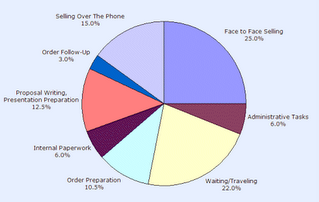But George Smith used the principles of total quality management to analyze sales processes. He found out where the "average" sales person is spending time and how to eliminate some of the waste. We've summarized his findings in the accompanying message. How do you think his numbers compare to your sales team?
Sales Productivity: Where Do Sales People Spend Their Time?
How do sales people spend their time? How many hours do they work and how much of that effort is productive?
In Sales Productivity Measurement, published by ASQC Quality Press, George A. Smith, Jr. summarizes research from a variety of sources. He found that the average sales person works 47 hours a week, but the majority of that time was spent on non-selling activities. In fact, Smith suggests that 50% might be a conservative estimate of non-selling time.
A typical distribution of effort looks like this:

These numbers suggest that only 40% of a typical sales person's time is spent in direct customer contact.
New technology may eliminate some of the need for traveling. Using Internet-based presentation systems, sales people can make presentations in real time, talking with one or many prospects over the telephone while everybody has the same information displayed interactively on their computers.
But for many sales people, travel will always be necessary. It's going to be difficult to sell a big ticket solution without some face-to-face contact. Instead, the big gain will come from eliminating or slashing the amount of time spent on labor-intensive activities, particularly the creation of proposals and presentations.
In fact, I think in a few years it will seem as silly to do proposals and presentations the old-fashioned way, cutting and pasting and writing by hand, as it would be to go back to typewriters.
To learn more ways to improve sales force productivity through automation, visit us at www.santcorp.com.




